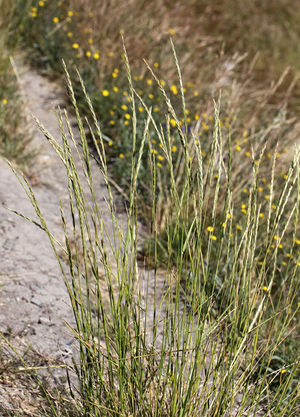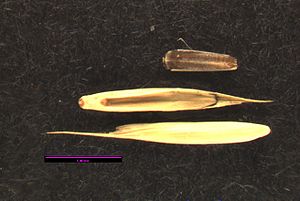Elymus trachycaulus
- Scientific Name: Elymus trachycaulus
- Family: Poaceae
- Common Names: slender wheatgrass
- Synonyms/Misapplications: Agropyron caninum, Agropyron trachycaulum, Roegneria trachycaula, Triticum trachycaulum
- Codon: ELYTRA
Contents
Taxonomy
| Scientific classification | |
|---|---|
| Kingdom: | Plantae |
| Subkingdom: | Viridiplantae |
| Phylum: | Tracheophyta |
| Subphylum: | Spermatophytina |
| Class: | Magnoliopsida |
| Subclass: | Lilanae |
| Order: | Poales |
| Family: | Poaceae |
| Genus: | Elymus L. |
| Species: | Elymys trachycaulus (Link) Gould ex. Shinners |
| Synonyms | |
| |
Description
Perennial, caespitose, erect bunchgrass with terminal spikes, growing to 120 cm tall.[2] Root system dense, fibrous, possibly with short rhizomes.[2] Culms hollow,[3] nodes usually glabrous.[4] Leaves more concentrated basally; sheaths usually glabrous,[4] open;[3] Spikes with one spikelet per node;[4] spikelets with 3-9 florets;[4] articulation point above the glumes; glumes equal or nearly so, 3-7 veined with 0.1-0.5 mm hyaline margin;[3] lemmas 6-13 mm,[4] glab to sparsely hairy, straight awns 0-40 mm;[3] paleas nearly equal to lemmas, keeled.[4]
Bloom Period
July-August[2]
Distribution
Widely distributed across North America.[2]
Habitat
Semiarid areas, temperate and boreal forests, subalpine and alpine habitat. Dry to moist, fine and medium-textured soils with pH 5.6-9.0. Has high salinity and drought tolerance but is shade intolerant. Primary and secondary successional species.[2]
Uses
First Nations Use as feed for horses by Navajo and Thompson peoples.[5]
Site Rehabilitation: Slender wheatgrass is recommended for inclusion in reclamation mixes because of its good seedling vigor and establishment qualities. It is also somewhat tolerant of saline soils. Slender wheatgrass seedlings are vigorous and provide good initial plant cover in seed mixtures. Plants tend to be short-lived, thus giving other plants a chance to become established.[6]
Wildlife: High palatability for browsing and grazing animals. Grazed by sage grouse, deer, elk, moose, bighorn sheep, mountain goat, pronghorn, various rodents, and all classes of livestock. The seeds are eaten by various seed predators.[6]
Propagation
Seeds should be planted in a firm, weed-free seed bed. Dormant fall planting is preferred for dryland seedings made in areas receiving less than 16 inches mean annual precipitation. Areas receiving over 16 inches of mean annual precipitation and fields that are irrigated can be seeded in late fall or early spring. (Note: dormant fall seedings are more prone to be negatively affected by soil crusting and mid to late spring seedings are more prone to drying out). Seeds should be drilled to a depth of ¼ to ¾ inch at a Pure Live Seed (PLS) rate of approximately 6 lb PLS/acre for field plantings.
For critical area plantings, turf applications and broadcast plantings the PLS seeding rate should be 1.5 to 2.0 times the drill seeding rate.
For native seed mixtures, limit slender wheatgrass to 1 to 2 pounds PLS/acre because higher rates effect the establishment of slower developing native species.
Fertilizer is not recommended for establishment, as it usually benefits the weeds. On disturbed sites fertilizer should be applied according to soil test results.
Plant at a rate of approximately 3.4 pounds PLS/acre or 25 to 30 seeds per linear foot of drill row at 36 inch row spacing. For stand establishment, apply 55 lb/acre of 11-55-0 (high phosphorus fertilizer) as a soil amendment prior to planting or during seeding. If planting into grain stubble, after initial seedling establishment, apply 30 lb/acre nitrogen for dryland or 60 to 80 lb/acre nitrogen for irrigated fields. No additional nitrogen is necessary if planting into summer fallow. Irrigate enough to keep soil moist for establishment and to prevent soil crusting. Seeds should germinate within 8 to 10 days.
Weeds can be controlled after the 3 to 5 leaf stage with low rates of Bromoxynil. Be sure to read and follow all label directions when using any pesticide. Caution should be exercised when using cultivation on young seedlings because of the possibility of uprooting.
For established stands, apply 50 lb/acre nitrogen each year in late fall on dryland and 60 to 80 lb/acre nitrogen in late fall under irrigation.
On established stands keep soil moisture above fifty percent field capacity during the growth period. Before the flowering stage apply enough water to carry plants through pollination. After pollination, irrigate to recharge the soil profile for seed set.
Control weeds chemically (Bromoxynil, Metribuzin, 2,4-D or dicamba), by roguing or mechanical cultivating. Seed yields range from 200 to 400 lb/acre in dryland to 500 to 600 lb/acre under irrigation. Seed should be dried to 12 percent or less moisture prior to storage. Stands can be expected to survive for 3 to 5 years.[7]
Seed
Abbreviation: ELTR
Seed sample from: 2009
Average Measurement including husk and awn: 13.6 x 1.3 x 1
Measurement Range including husk and awn: L: 11 - 14, W: 1.1 - 1.5, D: 0.9 – 1.1
Average Measurement without husk or awn: 5.5 x 1.1 x 1
Measurement Range without husk or awn: L: 5.2 – 5.75, W: 1 - 1.3, D: 0.9 – 1.1
Features
Shape: Awns shorter or equal in length to the length of seed body. Inner seed is deeply concave longitudinally on one side with a tan line running longitudinally down the concave part.
Color: Husks tan to off white. Seed purple or tan with white membrane attached in parts. Hilium is a light brown circle.
Surface: The surface of husk is papillose, and husk edges are very finely toothed or bristly. Awns finely toothed or hairy.
Latitudinal cross section: elliptical 
Longitudinal cross section: elliptical ![]()
Photo Gallery
References
- USDA, NRCS. 2012. Elymus trachycaulus (Link) Gould ex Shinners ssp. trachycaulus - slender wheatgrass USDA PLANTS Profile, PLANTS Database (http://plants.usda.gov/java/profile?symbol=ELTRT, 7 May 2012). National Plant Data Team, Greensboro, NC 27401-4901 USA. Retrieved 05/14/2012.
- ↑ Integrated Taxonomic Information System. Retrieved from https://www.itis.gov/servlet/SingleRpt/SingleRpt?search_topic=TSN&search_value=502282
- ↑ 2.0 2.1 2.2 2.3 2.4 Howard, Janet L. 1992. Elymus trachycaulus. In: Fire Effects Information System, [Online]. U.S. Department of Agriculture, Forest Service, Rocky Mountain Research Station, Fire Sciences Laboratory (Producer). Available: https://www.fs.fed.us/database/feis/plants/graminoid/elytra/all.html
- ↑ 3.0 3.1 3.2 3.3 Hitchcock, C. L., Cronquist, A., Giblin, D., & Legler, B. et al. (2018). Flora of the Pacific Northwest: an illustrated manual. Seattle: University of Washington Press. pp. 791-792.
- ↑ 4.0 4.1 4.2 4.3 4.4 4.5 Flora of North America. Retrieved from http://dev.floranorthamerica.org/Elymus_trachycaulus
- ↑ Native American Ethnobotany Database. Retrieved from http://naeb.brit.org/uses/search/?string=Elymus+trachycaulus
- ↑ 6.0 6.1 USDA NRCS Plant Fact Sheet. Retrieved from https://plants.usda.gov/factsheet/pdf/fs_eltr7.pdf
- ↑ USDA NRCS Plant Guide. Retrieved from https://plants.usda.gov/plantguide/pdf/pg_eltrt.pdf




